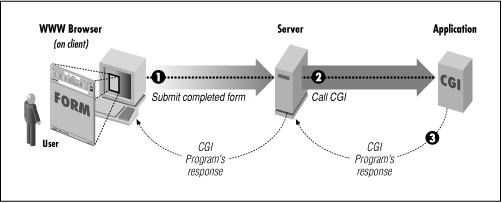HTML Complete Resources
Though it began as a military experiment and spent its adolescence as a sandbox for academics and eccentrics, recent events have transformed the worldwide network of computer networks–also known as the Internet–into a rapidly growing and wildly diversified community of computer users and information vendors. Today, you can bump into Internet users of nearly any and all nationalities, of any and all persuasions, from serious to frivolous individuals, from businesses to nonprofit organizations, and from born-again evangelists to pornographers.
In many ways, the World Wide Web–the open community of hypertext-enabled document servers and readers on the Internet–is responsible for the meteoric rise in the network’s popularity. You, too, can become a valued member by contributing: writing HTML documents and making them available to web “surfers” worldwide.
See Online
The Common Gateway Interface (CGI) programming
As you traverse the vast frontier of the World Wide Web, you will come across documents that make you wonder, “How did they do this?” These documents could consist of, among other things, forms that ask for feedback or registration information, imagemaps that allow you to click on various parts of the image, counters that display the number of users that accessed the document, and utilities that allow you to search databases for particular information. In most cases, you’ll find that these effects were achieved using the Common Gateway Interface, commonly known as CGI.

See Online
JavaScript Step By Step Guide
JavaScript is a lightweight interpreted programming language with rudimentary object-oriented capabilities. The general-purpose core of the language has been embedded in Netscape Navigator and other web browsers and embellished for web programming with the addition of objects that represent the web browser window and its contents. This “client-side” version of JavaScript allows “executable content” to be included in web pages–it means that a web page need no longer be static HTML, but can include dynamic programs that interact with the user, control the browser, and dynamically create HTML content.
See Online
Programming Perl
We think that Perl is an easy language to learn and use, and we hope to convince you that we’re right. One thing that’s easy about Perl is that you don’t have to say much before you say what you want to say. In many programming languages, you have to declare the types, variables, and subroutines you are going to use before you can write the first statement of executable code
See Online
Complete Webmaster Resource at Nutshell
This book is for everyone who works on the content end of the World Wide Web. Do you author or maintain Web documents? Do you work with CGI for creating fill-out forms? Are you a programmer developing client or server Web-based applications? Do you write JavaScript applets? Are you the administrator of a Web site, responsible for maintaining and updating the server software?
There are innumerable books and online resources for learning Web-related skills. What this book does is pare them down to a single desktop-sized volume for easy reference. You may be a whiz at CGI programming, but forget how to use Netscape cookies. You may know HTML fairly well, but can never remember the correct syntax for creating tables. You might forget the directive for creating directory aliases on your server, or how to enforce password protection on documents.
See Online